Power Quality Disturbance Tracking Based on a Proprietary FPGA Sensor with GPS Synchronization
Abstract
:1. Introduction
- This paper describes a low-cost proprietary system which implements a methodology to track the propagation of PQDs by performing synchronized measurements, using GPS, between different proprietary data loggers located at different points in the grid. This is due to the fact that other systems perform punctual PQ analysis of a certain number of PQDs, and some other works do not use GPS, using other synchronization techniques which have limitations that compromise the synchronization of the measurements.
- This paper shows the hardware implementation of a full PQD parameterized model based on PSO and GAs that allows the detection and classification of several PQDs. Other works only allow the detection of a limited number of PQDs and perform offline detection.
2. Theoretical Background
2.1. PQD
2.2. Transient
2.3. Voltage Fluctuation
2.4. Harmonic Content
2.5. Wavelet Transform (WT)
2.6. Hilbert–Huang Transform (HHT)
2.7. Genetic Algorithms (GAs)
2.8. Particle Swarm Optimization (PSO)
3. Proprietary PQD Detection System
4. Methodology for Propagation Detection of PQDs
5. Results
5.1. Validation Setup
5.2. Transient Analysis
5.3. Voltage Fluctuation Analysis
5.4. Harmonic Content Analysis
6. Discussion
7. Conclusions
Author Contributions
Funding
Institutional Review Board Statement
Informed Consent Statement
Data Availability Statement
Conflicts of Interest
References
- Rodriguez-Guerrero, M.A.; Jaen-Cuellar, A.Y.; Carranza-Lopez-Padilla, R.D.; Osornio-Rios, R.A.; Herrera-Ruiz, G.; Romero-Troncoso, R.D.J. Hybrid Approach Based on GA and PSO for Parameter Estimation of a Full Power Quality Disturbance Parameterized Model. IEEE Trans. Ind. Inform. 2018, 14, 1016–1028. [Google Scholar] [CrossRef]
- Wright, P.S.; Christensen, A.E.; Davis, P.N.; Larson, B.; Lippert, T.; Patel, P. Power quality propagation measurements in smart grids. In Proceedings of the 2016 Conference on Precision Electromagnetic Measurements (CPEM 2016), Ottawa, ON, Canada, 10–15 July 2016; pp. 16–17. [Google Scholar] [CrossRef]
- SEL-735 Power Quality Meter and Billing|Schweitzer Engineering Laboratories. Available online: https://selinc.com/es/products/735/ (accessed on 8 May 2021).
- Basic Three-Phase Power Quality Recorder Fluke 1760TR|Fluke. Available online: https://www.fluke.com/es-mx/producto/comprobacion-electrica/calidad-electrica/1760tr-basic (accessed on 8 May 2021).
- Chawda, G.S.; Shaik, A.G.; Shaik, M.; Padmanaban, S.; Holm-Nielsen, J.B.; Mahela, O.P.; Kaliannan, P. Comprehensive Review on Detection and Classification of Power Quality Disturbances in Utility Grid with Renewable Energy Penetration. IEEE Access 2020, 8, 146807–146830. [Google Scholar] [CrossRef]
- Mishra, M. Power quality disturbance detection and classification using signal processing and soft computing techniques: A comprehensive review. Int. Trans. Electr. Energy Syst. 2019, 29. [Google Scholar] [CrossRef] [Green Version]
- Rodriguez-Guerrero, M.A.; Carranza-Lopez-Padilla, R.; Osornio-Rios, R.A.; de J. Romero-Troncoso, R. A novel methodology for modeling waveforms for power quality disturbance analysis. Electr. Power Syst. Res. 2017, 143, 14–24. [Google Scholar] [CrossRef]
- Borrás-Talavera, M.D.; Bravo, J.C.; Álvarez-Arroyo, C. Instantaneous disturbance index for power distribution networks. Sensors 2021, 21, 1348. [Google Scholar] [CrossRef]
- Divya, S.; Uma Rao, K. Comparative performance of different wavelets in Power Quality disturbance detection and quantification. In Proceedings of the 2016 Second International Conference on Cognitive Computing and Information Processing (CCIP), Mysuru, India, 12–13 August 2016; pp. 1–5. [Google Scholar] [CrossRef]
- Granados-Lieberman, D.; Valtierra-Rodriguez, M.; Morales-Hernandez, L.A.; Romero-Troncoso, R.J.; Osornio-Rios, R.A. A Hilbert transform-based smart sensor for detection, classification, and quantification of power quality disturbances. Sensors 2013, 13, 5507–5527. [Google Scholar] [CrossRef] [Green Version]
- Lazaroiu, G.C.; Golovanov, N.; Balaban, G.; Corti, M.; Tironi, E.; Zaninelli, D. Flicker propagation in power systems supplying wind farms. In Proceedings of the International Conference on Harmonics and Quality of Power, ICHQP, Belo Horizonte, Brazil, 16–19 October 2016; Volume 2016-Decem, pp. 66–70. [Google Scholar]
- Pungut, N.A.F.B.; Hannoon, N.M.S.; Ibrahim, P. Bin Power Analysis of Autonomous Microgrid. J. Sci. Ind. Res. 2017, 76, 626–630. [Google Scholar]
- Carta, D.; Muscas, C.; Pegoraro, P.A.; Sulis, S. Identification and Estimation of Harmonic Sources Based on Compressive Sensing. IEEE Trans. Instrum. Meas. 2019, 68, 95–104. [Google Scholar] [CrossRef]
- Nieto, A.; Vita, V.; Maris, T.I. Power Quality Improvement in Power Grids with the Integration of Energy Storage Systems. Int. J. Eng. Res. Technol. 2016, 5, 438–443. [Google Scholar]
- Nieto, A.; Vita, V.; Ekonomou, L.; Mastorakis, N.E. Economic Analysis of Energy Storage System Integration with a Grid Connected Intermittent Power Plant, for Power Quality Purposes. WSEAS Trans. Power Syst. 2016, 11, 65–71. [Google Scholar]
- Chmielowiec, K.; Wiczynski, G.; Rodziewicz, T.; Firlit, A.; Dutka, M.; Piatek, K. Location of power quality disturbances sources using aggregated data from energy meters. In Proceedings of the 2020 12th International Conference and Exhibition on Electrical Power Quality and Utilisation-(EPQU), Cracow, Poland, 14–15 September 2020; pp. 3–7. [Google Scholar] [CrossRef]
- Artale, G.; Caravello, G.; Cataliotti, A.; Cosentino, V.; Di Cara, D.; Dipaola, N.; Guaiana, S.; Panzavecchia, N.; Sambataro, M.G.; Tinè, G. Pq and harmonic assessment issues on low-cost smart metering platforms: A case study. Sensors 2020, 20, 6361. [Google Scholar] [CrossRef]
- Martinek, R.; Bilik, P.; Baros, J.; Brablik, J.; Kahankova, R.; Jaros, R.; Danys, L.; Rzidky, J.; Wen, H. Design of a measuring system for electricity quality monitoring within the smart street lighting test polygon: Pilot study on adaptive current control strategy for three-phase shunt active power filters. Sensors 2020, 20, 1718. [Google Scholar] [CrossRef] [Green Version]
- Moreno-Garcia, I.M.; Palacios-Garcia, E.J.; Pallares-Lopez, V.; Santiago, I.; Gonzalez-Redondo, M.J.; Varo-Martinez, M.; Real-Calvo, R.J. Real-time monitoring system for a utility-scale photovoltaic power plant. Sensors 2016, 16, 770. [Google Scholar] [CrossRef] [Green Version]
- Morales-Velazquez, L.; Romero-Troncoso, R.J.; Herrera-Ruiz, G.; Morinigo-Sotelo, D.; Osornio-Rios, R.A. Smart sensor network for power quality monitoring in electrical installations. Meas. J. Int. Meas. Confed. 2017, 103, 133–142. [Google Scholar] [CrossRef]
- Sudrajat, M.I.; Moonen, N.; Bergsma, H.; Bijman, R.; Leferink, F. Evaluating Rapid Voltage Changes and its Propagation Effect using Multipoint Measurement Technique. In Proceedings of the 2020 International Symposium on Electromagnetic Compatibility-EMC EUROPE2020, Rome, Italy, 23–25 September 2020; pp. 4–9. [Google Scholar] [CrossRef]
- Melo, I.D.; Pereira, J.L.R.; Variz, A.M.; Garcia, P.A.N. Harmonic state estimation for distribution networks using phasor measurement units. Electr. Power Syst. Res. 2017, 147, 133–144. [Google Scholar] [CrossRef]
- Khan, S.; Singh, B.; Makhija, P. A review on power quality problems and its improvement techniques. Int. J. Eng. Res. Technol. ENCADEMS 2020 2020, 8, 1–7. [Google Scholar] [CrossRef]
- Institute of Electrical and Electronics Engineers. IEEE Std 1159 IEEE Recommended Practice for Monitoring Electric Power Quality; IEEE: Piscatway, NJ, USA, 2009; Volume 2009. [Google Scholar]
- Huang, N.; Peng, H.; Cai, G.; Chen, J. Power quality disturbances feature selection and recognition using optimal multi-resolution fast S-transform and CART algorithm. Energies 2016, 9, 927. [Google Scholar] [CrossRef] [Green Version]
- Saadat, A.; Hooshmand, R.-A.; Tadayon, M. Flicker Propagation Pricing in Power Systems Using a New Short-circuit Based Method for Determining the Flicker Transfer Coefficient. IEEE Trans. Instrum. Meas. 2020, 9456, 1–9. [Google Scholar] [CrossRef]
- Masoum, M.A.S.; Fuchs, E.F. Introduction to Power Quality; European Copper Institute: Woluwe-Saint-Pierre, Beligum, 2015; ISBN 9780123695369. [Google Scholar]
- Eghtedarpour, N.; Farjah, E.; Khayatian, A. Effective Voltage Flicker Calculation Based on Multiresolution S-Transform. IEEE Trans. Power Deliv. 2012, 27, 521–530. [Google Scholar] [CrossRef]
- Abdelrahman, S.; Wang, M.; Milanovic, J.V.; Becirovic, E. Study of harmonic propagation in transmission networks with high penetration of power electronics devices. In 2017 IEEE Manchester PowerTech, Powertech; IEEE: Piscatway, NJ, USA, 2017. [Google Scholar] [CrossRef]
- Ullah, A.; Sheikh, I.U.H.; Arshad, S.; Saleem, F. Digital Active Power Filter Controller Design for Current Harmonics in Power System. In Proceedings of the 2019 16th International Bhurban Conference on Applied Sciences and Technology (IBCAST), Islamabad, Pakistan, 8–12 January 2019; pp. 384–388. [Google Scholar] [CrossRef]
- Khetarpal, P.; Tripathi, M.M. A critical and comprehensive review on power quality disturbance detection and classification. Sustain. Comput. Inform. Syst. 2020, 28, 100417. [Google Scholar] [CrossRef]
- Jaen-Cuellar, A.Y.; Morales-Velazquez, L.; Romero-Troncoso, R.J.; Moriñigo-Sotelo, D.; Osornio-Rios, R.A. Micro-genetic algorithms for detecting and classifying electric power disturbances. Neural Comput. Appl. 2017, 28, 379–392. [Google Scholar] [CrossRef]

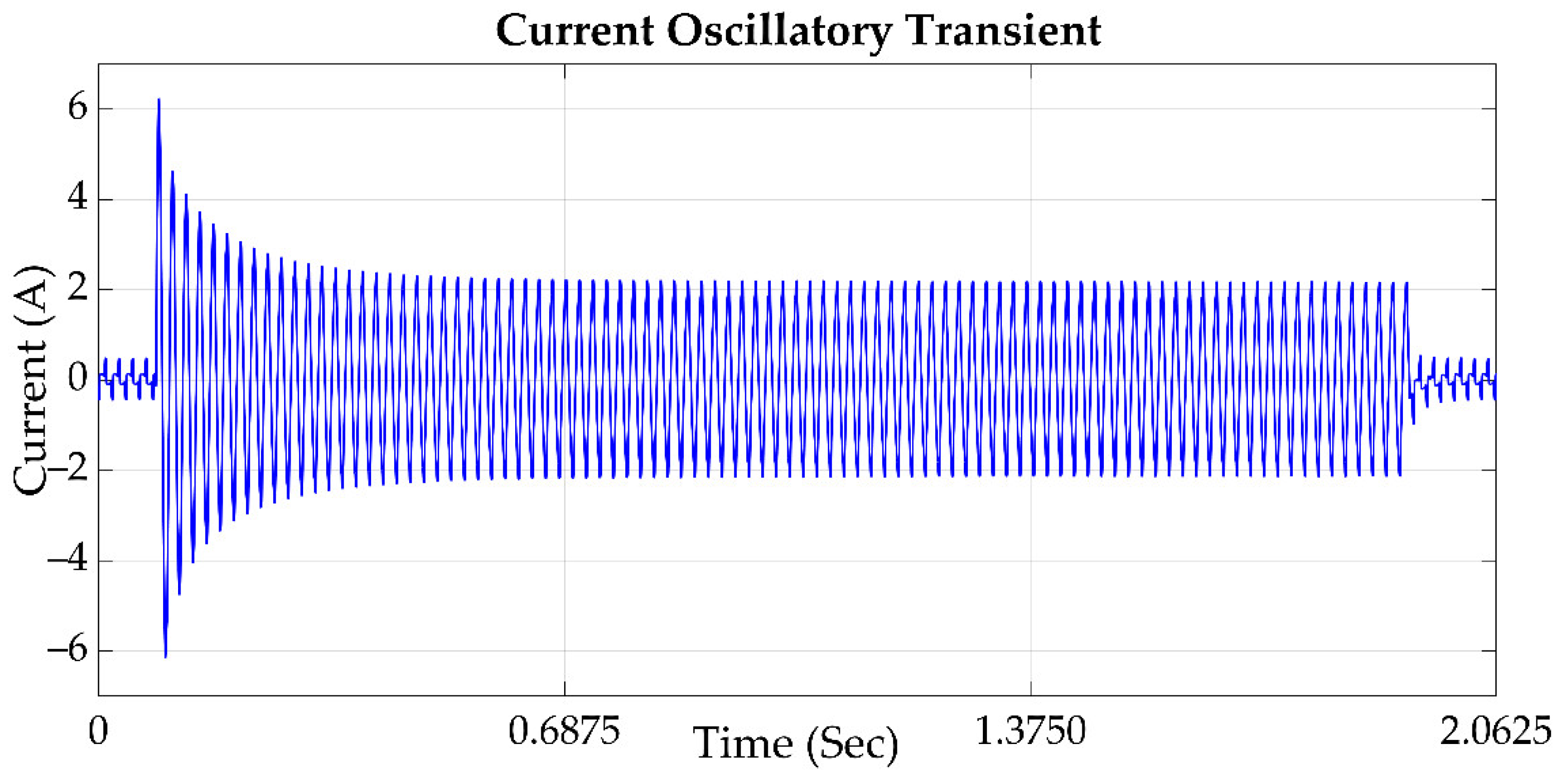


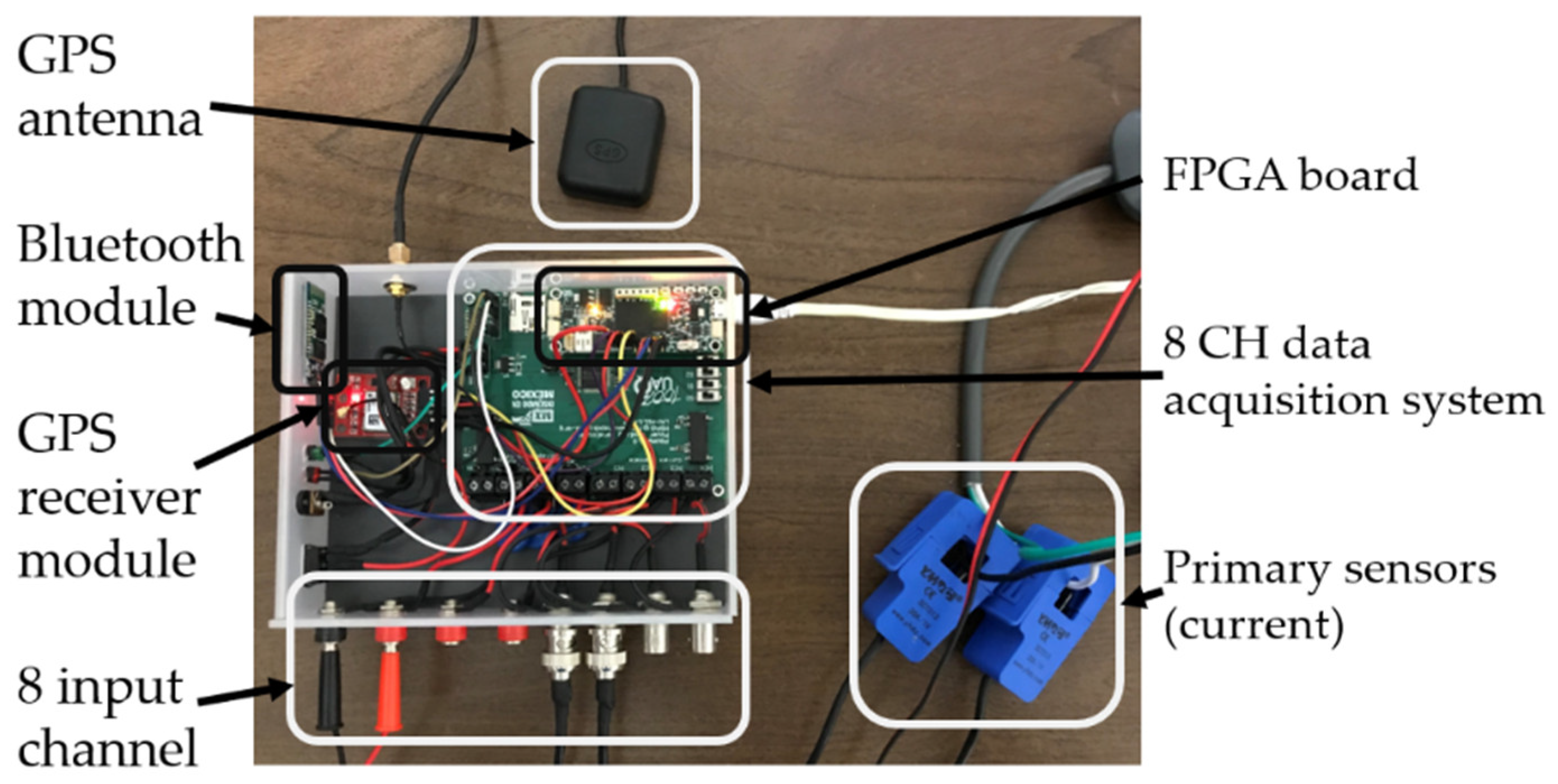
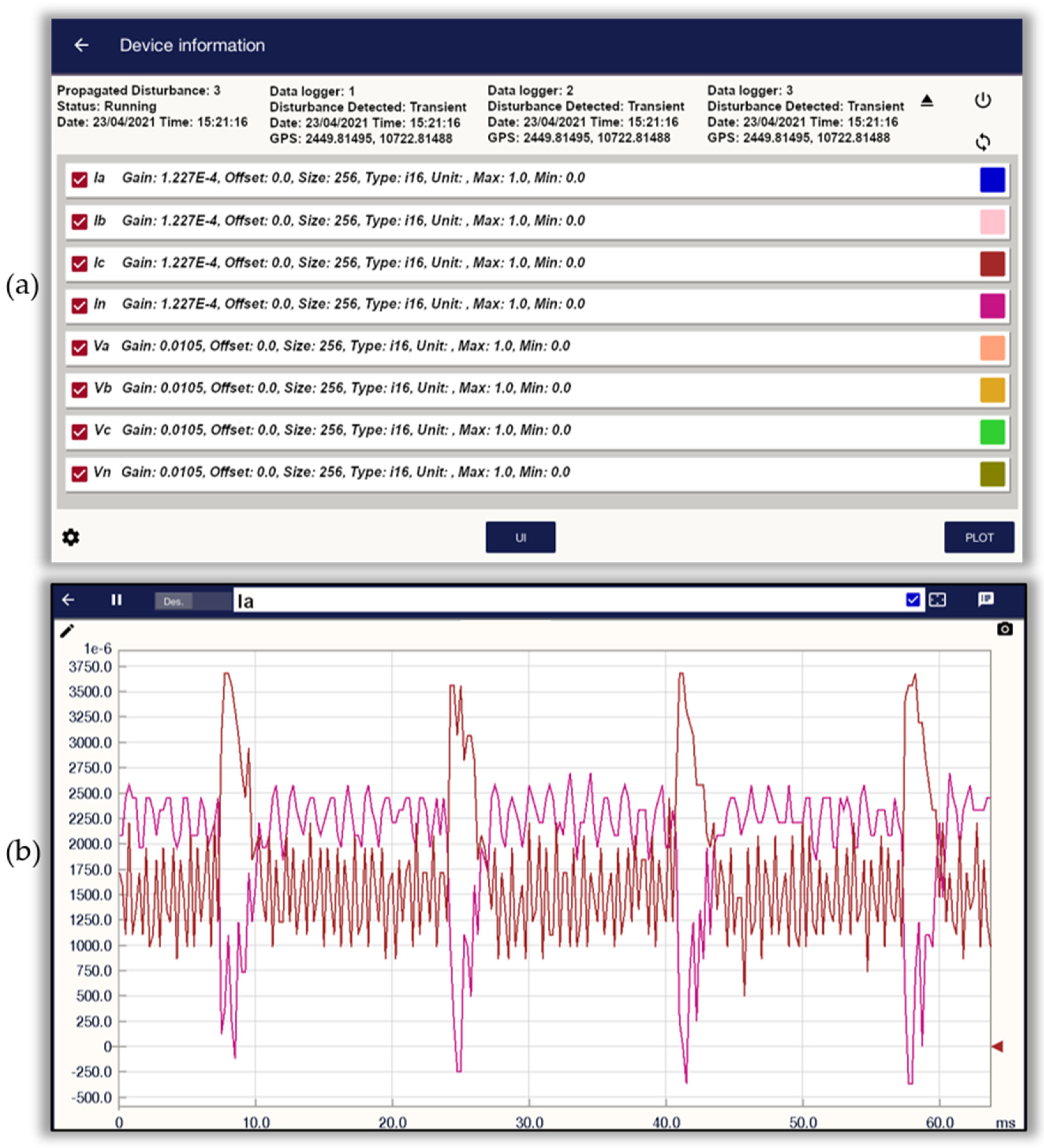


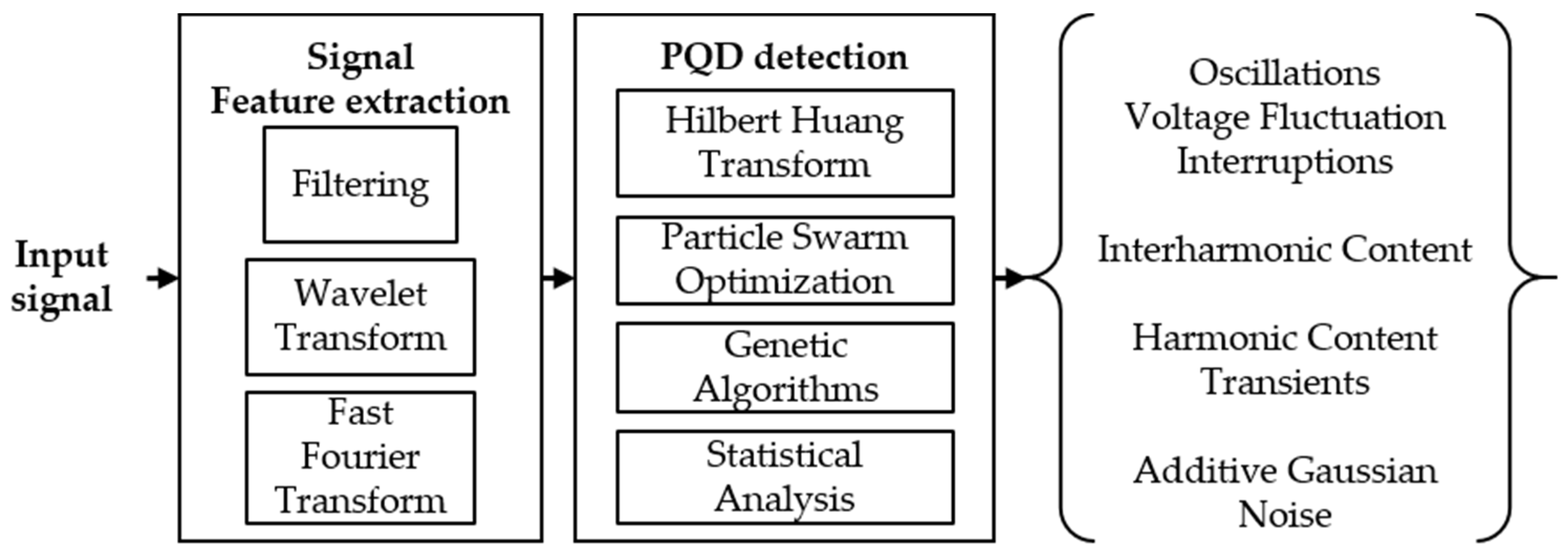
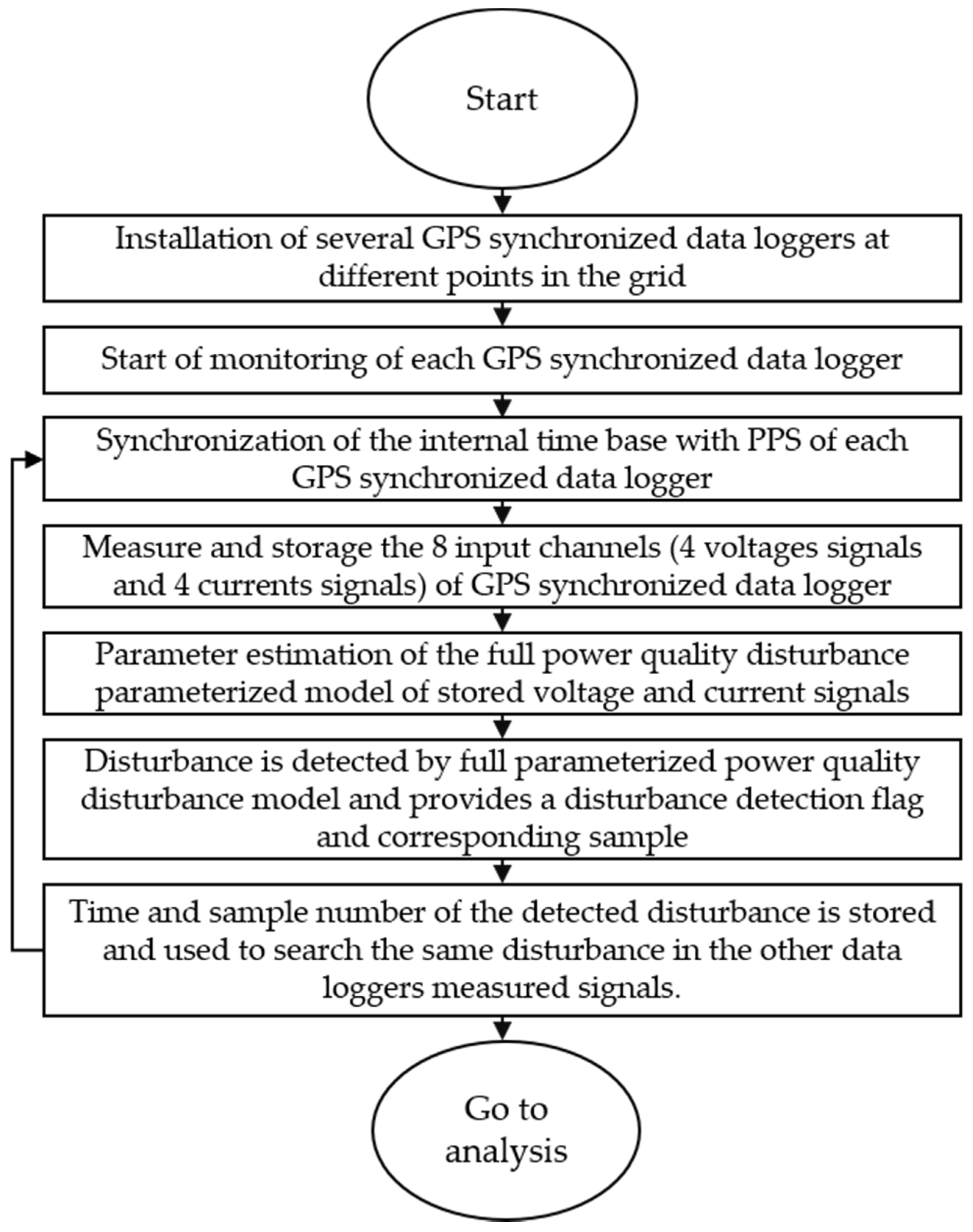

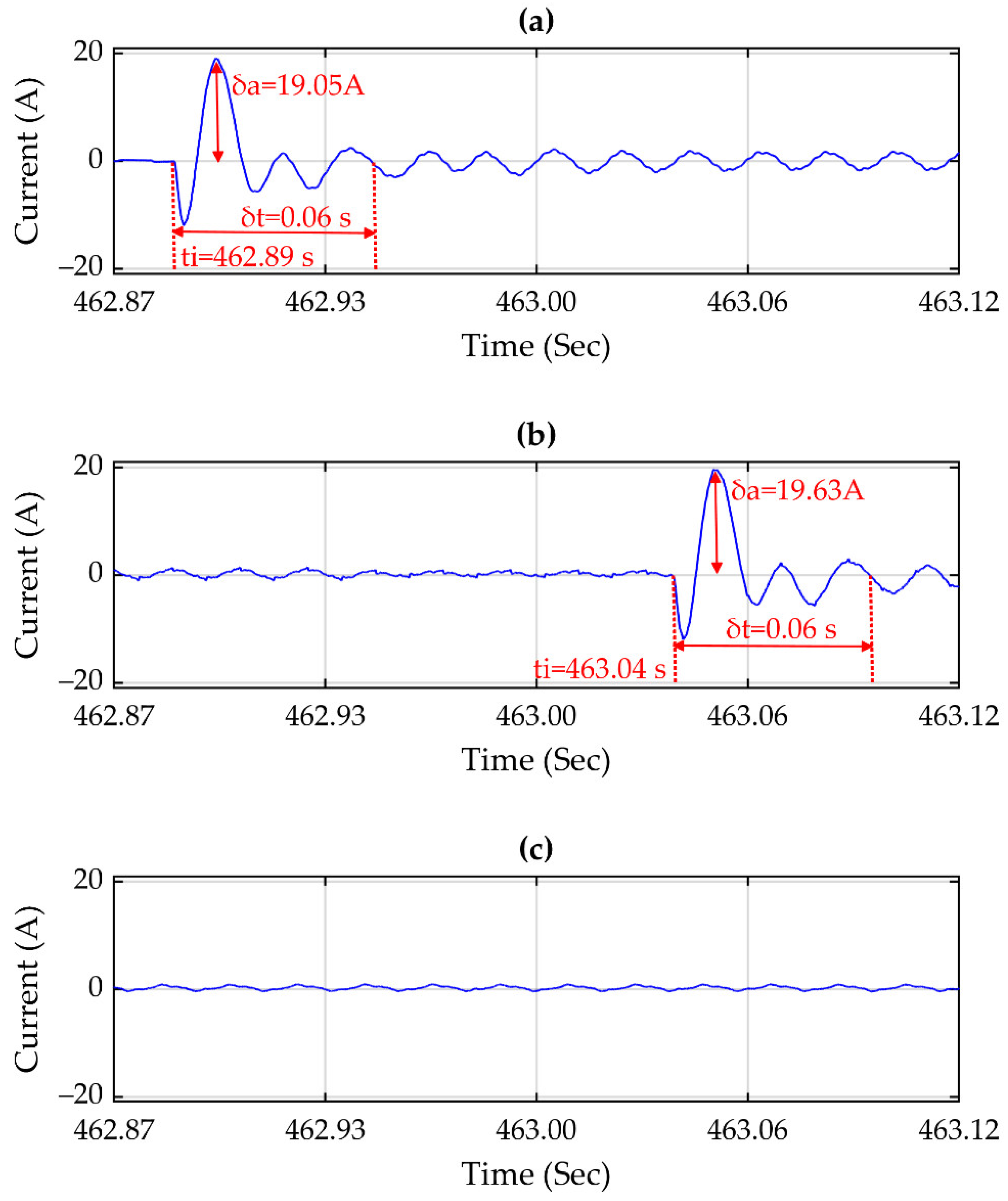
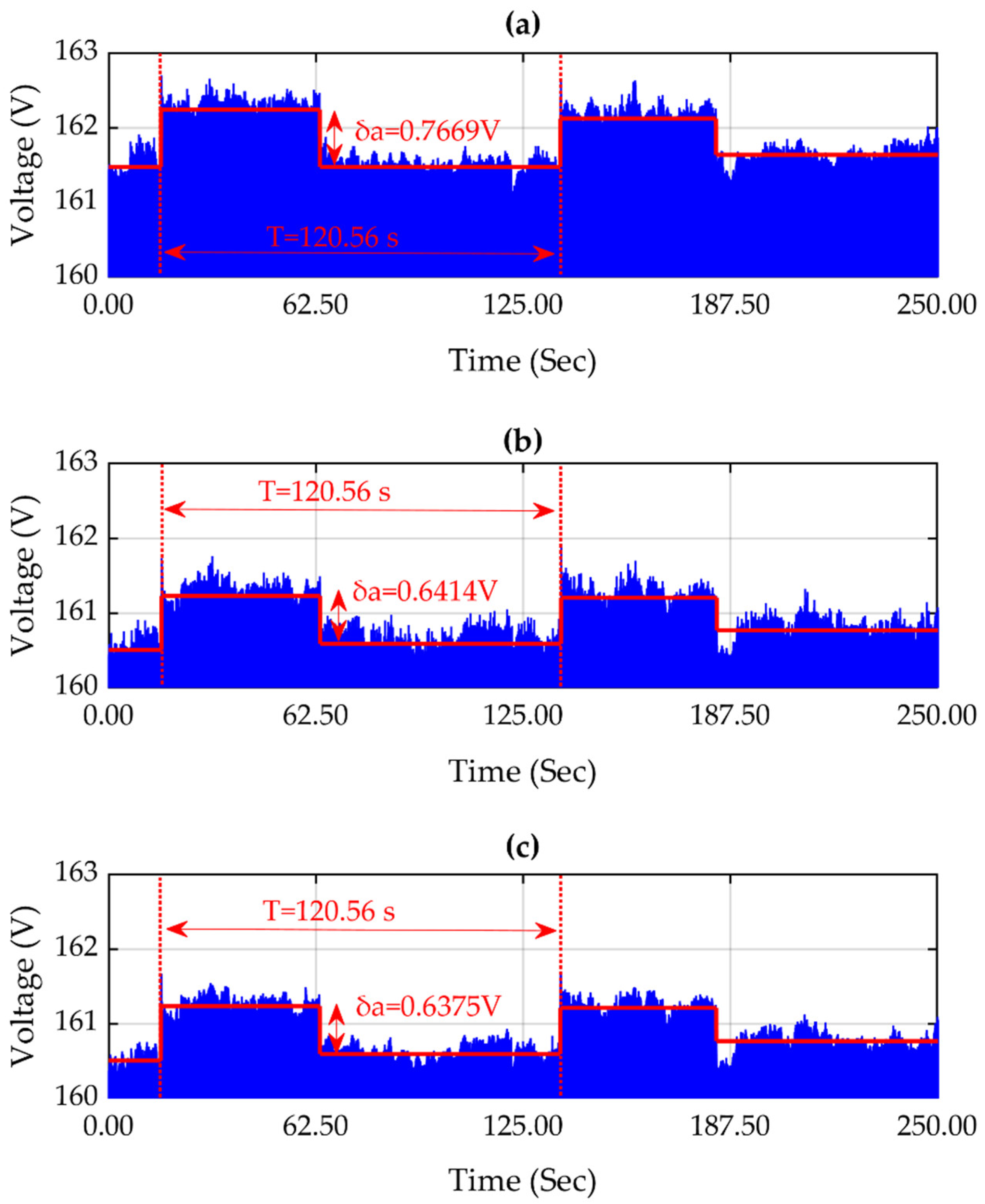
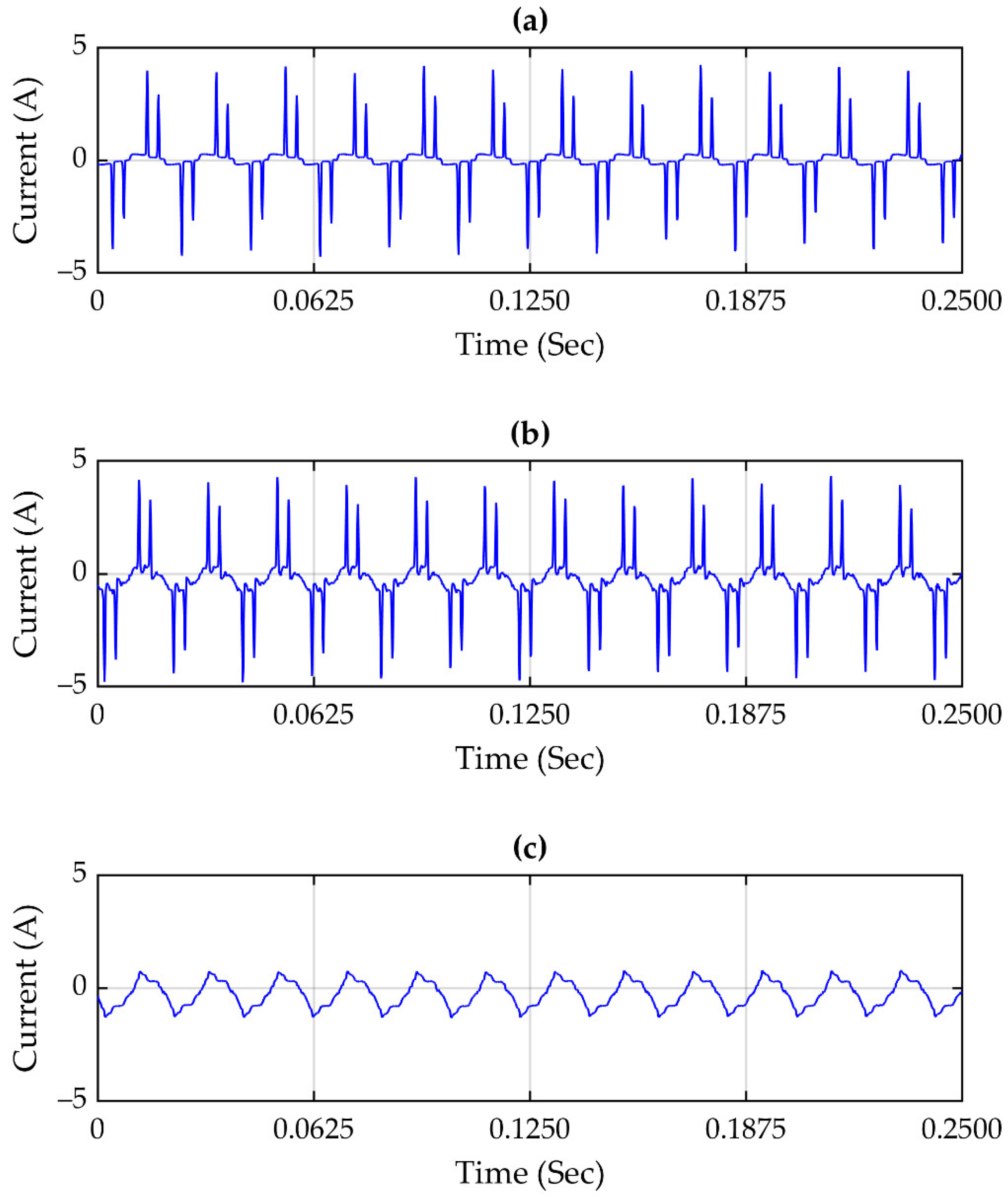

| Component | Model | Feature | Functionality |
|---|---|---|---|
| FPGA | Xilinx® FPGA Spartan6 (XC6SLX16) | 14579 Logic Elements. 186 Input/Output. Voltage supply: 1.2 V. Integrate Memory: 576 kbit. | It is the main core of the data logger—it coordinates all the modules, controls the ADC acquisition, synchronizes its internal base with the PPS, and processes the measured signals. |
| ADC | Texas Instruments® (ADS130E08) | 16-bit conversion. 8 input channels. 8000 samples per second. Interface Serial Peripheral Interface (SPI). Architecture Delta-Sigma. | The ADC performs the conversion of electrical signals, this ADC contains 8 channels which are used to measure three-phase electrical signals, and its cost–benefit ratio is acceptable for the application. |
| GPS module receiver | Blox Neo 6M-0-001 | Position accuracy: ±2 m. Communication protocol: National Marine Electronics Association (NMEA), Radio Technical Commission for Maritime Services (RTCM). Sensibility del receptor: −161 dBm. Voltage supply: 2.7–3.6 VCC. Provides PPS signal. | This low-cost GPS module is responsible for providing the PPS for the synchronization of measurements, and it is a generic module which is easily accessible to the public. |
| Bluetooth module | BlueCore 4-External BC417143BGO | Bluetooth 2.4 GHz. Enhanced data rate to 3 Mbps. + 6 dBm Radio frequency transmit power. Standard Human Computer Interaction (HCI). | The Bluetooth module maintains communication with the mobile interface, the cost–benefit ratio is appropriate for the application, and it is easily accessible to the public. |
| System | Capabilities | Disadvantages |
|---|---|---|
| PMU [22] | PMU can directly measure frequency, voltage, and current waveforms along with phase angle differences at high sampling rates, and with great accuracy. PMU utilizes a GPS reference source to provide the required synchronization across wide geographical areas. | Does not capture the raw waveform of voltage and current. Does not calculate PQD indices. High cost per unit. |
| PQ Analyzer [16,19,21] | PQ analyzer calculates some PQ indices in real time. Records electrical signals when it detects a disturbance. | Stores only PQDs detected, does not store the raw data of current and voltage signal. Performs punctual measurements in the grid. High cost per unit. |
| GSD, our proposal | Continuous measurement of raw waveform of voltage and current. GPS synchronization with PPS obtaining 1 error sample in 24 h during a PPS interruption. PQD detection on-line using GAs and PSO. PQD propagation monitoring. Low cost per unit. | Manual recovery of raw data to post-processing. Data storage limitation to 120 GB, approximately 2 weeks of monitoring. |
Publisher’s Note: MDPI stays neutral with regard to jurisdictional claims in published maps and institutional affiliations. |
© 2021 by the authors. Licensee MDPI, Basel, Switzerland. This article is an open access article distributed under the terms and conditions of the Creative Commons Attribution (CC BY) license (https://creativecommons.org/licenses/by/4.0/).
Share and Cite
Pardo-Zamora, O.N.; Romero-Troncoso, R.d.J.; Millan-Almaraz, J.R.; Morinigo-Sotelo, D.; Osornio-Rios, R.A.; Antonino-Daviu, J.A. Power Quality Disturbance Tracking Based on a Proprietary FPGA Sensor with GPS Synchronization. Sensors 2021, 21, 3910. https://doi.org/10.3390/s21113910
Pardo-Zamora ON, Romero-Troncoso RdJ, Millan-Almaraz JR, Morinigo-Sotelo D, Osornio-Rios RA, Antonino-Daviu JA. Power Quality Disturbance Tracking Based on a Proprietary FPGA Sensor with GPS Synchronization. Sensors. 2021; 21(11):3910. https://doi.org/10.3390/s21113910
Chicago/Turabian StylePardo-Zamora, Oscar N., Rene de J. Romero-Troncoso, Jesus R. Millan-Almaraz, Daniel Morinigo-Sotelo, Roque A. Osornio-Rios, and Jose A. Antonino-Daviu. 2021. "Power Quality Disturbance Tracking Based on a Proprietary FPGA Sensor with GPS Synchronization" Sensors 21, no. 11: 3910. https://doi.org/10.3390/s21113910









